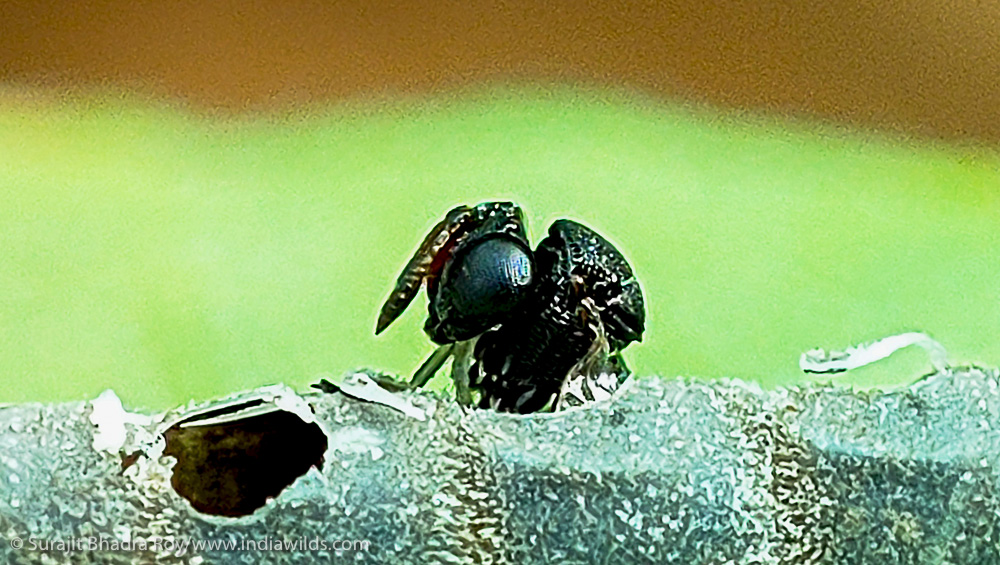A Tiny Phantom Friend Of Garden
by Surajit Bhadra Roy
Garden is the inseparable part of our city life. We like to plant various kinds of native and foreign fruit, flower and vegetable plants in our beloved gardens. Most unwanted guests in our garden are different kinds of insects. Many of us don’t like to see these creatures. However, it would be pertinent to mention that all insects are not harmful. The harmful insects cut, bore or chew the plant parts, some of those often invisible to us. To get rid of these harmful insects, people spray many insecticides on our lovely plants. Pesticides also indiscriminately destroy many useful insects. These chemical insecticides are toxic, poisoning the soil, water and air. They cause several diseases in people. It is the time we think twice before using those chemicals.
As we look at alternatives to pesticides, there may be some good news in form of a very tiny insect that may partially substitute the use of harmful insecticides. The insect is Psix sp., a tiny wasp of the family Platygastridae.
The Host:
The Red Pumpkin Bug (Coridius janus) is a major pest for different kinds of the plants in Cucurbitaceae family like pumpkin, cucumber, water melon, musk melon and more. It lays eggs in a single row at the under part of the foliage. Soon the nymphs emerge out. From the nymph to imago all of them penetrate their beak into the soft tissues of the plant and suck down the sap from there. Thus, the plant part gets weak and gradually dies out. The rate of their multiplication is very fast. Within a few weeks the total plant gets weakened and the leaves and soft parts get wrinkled.
The Bug Description:
The life cycle of Coridius janus is divided in three parts i.e. egg, nymph and imago.

Fresh eggs
The eggs are laid in a liner pattern, each egg is very small cylindrical shaped structure about 1.5 mm long and 1 mm thick. The fresh eggs are bluish-green in colour and the mature eggs turn blackish before hatching.

Mature eggs
When the eggs are hatched, the small nymphs come out. These are dark maroon wingless insects and vigorously engaged in sap shucking from the soft tissues of the creeper. It moults several times to reach in imago.

Imago
The imago is a medium sized bug of almost 1.5 cm long. As it is a heteroptera, the wing is having partially leathery and rest is membranous part. The head, the membranous part of the wing, the broader part of the scutellum is black in colour. Along with that, the head touching part of the pronotum has a black liner band. Rest of the body is orange to dark red in colour. The legs are also black.
The Wasp Description:
The wasp, Psix sp., is very small Platygastrid insect and black in colour with amber yellow legs. It is about 1 mm long. The frons without submedian carina, width of frons greater than height of compound eyes, metascutellum (dorsellum) protruding weakly, ventral lip of metascutellum punctulate after Johnson and Masner (1985).

Male wasp
In our case, the antenna of male is longer and less clubbed than the females. Besides, the size of abdomen is larger in female than male.

Female Wasp
Discussion:
The wasp, Psix sp., is a parasitoid insect on Coridius janus’s eggs. The female deposits one egg in each Coridius janus’s egg. The total metamorphosis of Psix sp. take place inside the egg of Coridius janus. When the eggs of Psix sp. is hatched, tiny larvae emerge and they feed on the internal matter of the Coridius janus’s egg. Soon it transformed into pupa and then imago.
First, the male imagos come out tearing the outer membrane of the host’s egg and they walk on the rest host eggs.

Male wasp waking up females
Sometimes, they hit the host eggs with the help of antenna like a drum-stick. The vibration of the antenna help awake the females, and they tear the outer layer of the Coridius janus’s egg in a circular manner. After tearing the layer, the females come out one by one.

Female wasp emerging
Immediately after the emergence of the females, the first task is mating even before they fly off. To ensure the maximum chance of successful mating, the males mate very fast with the females. Then the female wasps fly away to find another host egg mass. Here one male mates with multiple females.

Mating of Psix sp.
Conclusion:
Psix sp. is an egg parasitoid wasp on Coridius janus. It actively destroys the eggs of Coridius janus and controls the growth of its population. As the wasp destroys the pest, it acts as a good bio pest controller. Without using the harmful chemicals, this bioweapon can be used to control the pest population. It’ll not only destroy the pest, but it will help to produce the pesticide free vegetables.
There are several parasitoid wasps, moulds and microbs which are host specific and can be used in a broader spectrum instead of those fatal chemicals, to get more healthy fruits, crops and vegetables. The uses of parasitoid insects as a pest control are in very primitive state and the characters of the wasps and its collection process is very poorly studied. Though wasps can be collected from the wild for use in fields, however it would be a challenge to identify the wasps in the field. We can accumulate the wasp infected eggs from the wild and culture them artificially. It’ll also be a tough job for the farmers or gardeners. So it may be better to culture the hosts as the parasitoid wasps are host-specific. So they are likely to find them and from there we can isolate the wasps. It is important to study the parasitoidism to give benefits to our orchards and fields.
- A Tiny Phantom Friend Of Garden - 2 November,2022




Leave a Reply